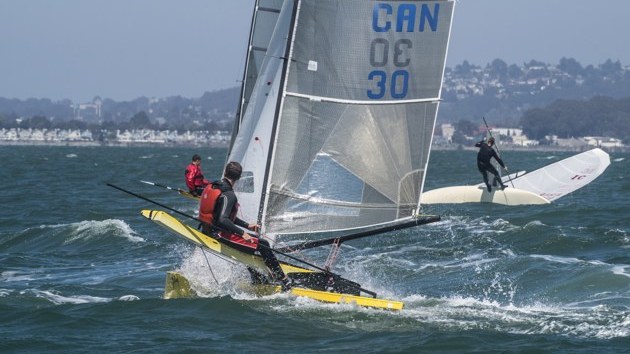The Decked Canoe Archives
Assembled by Tim Gittins
We challenge for the International Cup
from Sixty Years Behind the Mast - The Fox on the Water by Gordon K. (Sandy) Douglas
Starting at Chapter 10 page 123, then all of chapter 11
Chapter X
My being selected for the Canadian Olympic Paddling Team for the 1936 Olympics changed everything. Up to this time we had had no thought of going abroad. But with the opportunity presented by my being sent to Germany for the Olympics, it seemed only logical to stop off in England to try to retrieve the Challenge Cup which Uffa Fox and Roger de Quincey had taken from us in 1933. Prompted by this, we sent our challenge to the Royal Canoe Club, and with their prompt acceptance of the challenge the die was cast. The irony of it later was that I was turned down by the Olympic Committee, and did not go to Germany after all.
Now we realized that we were faced with having to have a new canoe built. Through this account of our preparations for, and our experiences in England, I will write of what "we" did, meaning my father and myself, because he was just as keenly interested in it as was I. This was something my father had dreamed about, and striven for, during his many years of canoe sailing. He had won the American championship. He had tried, but had not had the good fortune to be selected as one of the defenders at the times of challenges from England and Canada. Now, in the person of his son, he was challenging for the Cup.
To begin with, we knew that my sixteen by thirty Nymph was no match for the English canoes of 1933; and assumed, correctly, that by 1936 Uffa Fox would have developed a still better boat for Roger de Quincey who we assumed would be the defender. A new boat would be necessary, a seventeen-footer, the maximum length permitted. We had no American Uffa to design for us. Leo Friede's Mermaid, designed and built by Fred Gilbert, of Brockville, Ontario, over the years had been the outstanding sixteen-thirty. It seemed logical to us to commission Gilbert to build a new canoe, similar in lines, but with the length increased to seventeen feet and the beam to forty inches. And while the boat was being built, I was to build the spars, hardware and other equipment. In this regard it must be kept in mind that prior to the Second World War, there were no commercial makers of light-weight small-boat hardware. We canoeists either made our own, or had it custom-made by a specialty machine shop.
Now with the perspective of years and experience, today I realize how half-baked some of my efforts were. In 1928, Dr. Manfred Curry, one of Germany's leading racing skippers, brought out a fascinating book, Yacht Racing - The Aerodynamics of Sails and Racing Tactics, the first book to deal with scientific analysis of the effects on sailboats of wind and water. Some misguided but well-meaning soul gave me a copy of it, and I made the mistake of reading it, just as I was about to commence to build the rig for the canoe. As a result, I went more than a little overboard in trying to follow some of Dr. Curry's theories. I realized, later, that while his theories may be technically sound, putting some of them into practice was another matter.
Another matter was that my father, a gentleman of the old school, had not yet adjusted to modern design and materials. The old school believed that in order to be strong it had to be husky and - relatively - heavy. Lacking the facilities for building the masts ourselves, we had them built by Gilbert. I wanted to use very light masts with three-eighth-inch wall thickness, but nothing less than three-fourth-inch walls would suit my father, and so the masts were heavier than they needed to be. (The following year, when I built the mast for Foxy Nymph, I made the walls only one-fourth-inch thick.)
Another mistake was that, seduced by Manfred Curry's aerodynamic theories, I decided to use a rotating fairing, to turn with the sail from tack to tack, to streamline the mast. This was good in theory, but added weight to an already-heavy mast - and you will read in the next chapter how it caused trouble.
Dear reader, the next few pages become quite technical, so unless you are interested in technicalities of rigging the canoe and fabricating the hardware, I suggest your skipping the text up to where Mary and I start out for England on the Aquitania.
Also, following Curry's theories, I decided to use a rigid wooden jib stay of airfoil shape which was equipped to turn, from tack to tack, to fair into the luff of the jib, and also adding "free" sail area. The theory was good, the execution clumsy. The following year, for Foxy Nymph, I refined this wooden luff stay into a delicate splinter in comparison. We should have had an additional year for preparation.
Another idea developed from Curry was to mount the lower end of the wooden jib spar on what, for want of a better name, I call a spinnaker pole, which was mounted, at its inner end, on a gooseneck at the base of the mast. The jib spar was mounted on a sleeve which slid on the spinnaker pole, controlled by an outhaul line. For close-hauled sailing I allowed the jib spar to slide aft to a stop, giving the jib its normal overlap. When off the wind, I pulled the jib spar out to the end of the pole and then, with a guy on each side, was able to swing the pole out over the water to match the angle of the eased-out main boom, thus making the jib more effective on reaches and, especially, on runs. This rig required the use of four more cam cleats, in addition to the normal four cleats for the jib sheets and the two ends of the main sheet.
Special Hardware
A major problem for me was to design, and then to figure out how to fabricate, the innumerable articles of hardware for rigging the boat. Most of it required original thought because there was no precedent for fabricating lightweight boat hardware from the sheet metal I was to use. For thirty years so few canoes had been built that there no longer was a source for canoe hardware. The only available small-boat hardware was of cast bronze, heavy and clumsy, designed for larger boats. Now I was living in a different age, the age of new metals, of aluminum alloys of light weight and great strength. Instead of going the traditional way of making wooden patterns for casting the hardware, I designed the hardware for fabrication from a special corrosion-resistant aluminum alloy called, at that time, duraluminum or dural, which I bought in sheet form or in strips one-sixteenth-inch thick and an inch wide. From this I was able to make single blocks, double blocks, swivel blocks, goosenecks, shackles, etc. In my lathe I turned out my halyard and other sheaves from canvas-base bakelite.
Some of the hardware was simple in conception and construction. To make a single block, for example, the first step is to saw a short strip of dural into an attenuated dumbell shape. Next drill a hole at the center of each end, then bend it into a U, place a sheave between the ends, insert a piece of three-sixteenth-inch rod through the holes and form a head at each end of the pin. Voila! A single bullet block. It was from this simple basic form that I evolved ideas for all sorts of complicated hardware.
My greatest challenge came in figuring out how to fabricate the eight necessary semiautomatic cam cleats. The customary cam cleat has two jaws to grip a line put between them. To free the line it must be pulled from between them; to make them hold, the line must be placed back between them. For the canoe sailor, who has oniy two or three seconds, as he tacks, to trim both ib and main sheets, at the same time sliding the seat and tiller across and perhaps also adjusting the centerboard, the canoe sailor demands a quicker-acting cleat with a lever to open or close it, a lever he can open with a foot while he is out on the seat.
Traditionally such cleats, invented by Paul Butler in 1888, always had been made with bronze castings for the shell and the lever. To save weight I decided to fabricate the cleats from dural tubing and bar stock - flattened tubing forming the shell.
(In succeeding years I made many more of these for the sailing canoes I built, but did not bother to patent them. Several years after I gave up building canoes, persons unknown - and I didn't even bother to find out - copied my cleats in detail and put them on the market as the Jiffy Cleat. Their adventure in piracy was not commercially successful.) (And in a later chapter I will tell how two prominent small-boat hardware manufacturing companies were founded with their products based to a considerable extent on my original ideas.)
Mary and I Set Sail For England Aboard the Aquitania
The winter of 1935-36 was indeed a busy one for me with my time spread over bullding the spars and hardware for the canoe, my painting, my travels around New Jersey attempting to sell Living American Art to the schools. Soon it was June. We took the new boat to Long Island Sound for trial against other canoes. She went well. Then it was time to haul the new boat to Gananoque where we crated her for shipment to England, accompanied by my father. Because of the conflicting date of the Canadian Paddling Championship races at Sudbury - where I won the double-blade tandem and four races - Mary and I could not meet the Montreal sai1ing. Instead, as soon as the paddling was past, we went to New York for passage to England aboard the Aquitania, to meet my father in Southampton.
Our voyage on the Aquitania was delightful but for one thing. The Aquitania had been at her pier in New York for most of a week during a heat wave, with the result that the entire ship was as hot as an oven through and through, so hot it took several days at sea for her to cool down. This was before the time of air conditioning, and while the air on deck was cool, in our cabin at night we sweltered.
The main lounge had an excellent piano which Mary would have liked to play. I urged her to try it, but despite the fact that she is a fine pianist of concert caliber, her nature is such that she is reticent for fear that she might annoy someone. One evening we had an early dinner in the hope that no one would be in the lounge. It was empty, and Mary commenced to play a Handel Capriccio. She became so rapt in her music that she was not aware that the lounge was filling with ex-diners. It was a shock, as she turned away from the piano, to be greeted by a great burst of enthusiastic applause.
Very early in the morning we pulled into Cherbourg to let off some passengers. Soon again we headed out across the Channel for the Isle of Wight and Southampton where Father and the canoe would be waiting for us, as well as Uffa Fox, Roger de Quincey and the many friends we would make.
Chapter XI
The International Cup Races
Our destination aboard the Aquitania was Southampton, England, an ancient city standing near the head of Southampton Water, an inlet from the Solent and the English Channel. Situated on a peninsula bounded on the east by the River Itchen, Southampton is a major English seaport. Still to be seen are the stones of a walled Roman settlement, the remains of a Saxon Fortress, and despite heavy bombing in the Second World War, parts of the old Norman walls are still standing, strengthened at intervals by towers. The south and west gates date from the early fourteenth century.
Father, Mary and I traveled by a branch railroad to Hayling Island, the scene of the coming races, enjoying the comfort of a compartment all to ourselves in (to our eyes) one of the tiny coaches. Soon we had traversed the twenty miles from Southampton to Hayling Island where we found rooms in a small vacation hotel just across the highway from the beach and the English Channel. Hayling Island, which forms the west side of Chichester Harbor where the races were to be sailed, is an island several miles in extent. By the time we arrived it was nearing 7:00 p.m., and Father urged us to clean up with alacrity so as to go down to a tardy dinner. To our surprise we found the dining room empty. We enjoyed our dinner despite the rather slow service - and it was only as we were leaving that we found other diners commencing to enter the living room. We had forgotten that the English dine at a late hour.
All his life Father had been accustomed to having his dinner early, generally at 6:30 p.m. In anticipation of the early dinner he made it a rule never to eat anything in the afternoon, after his lunch, and now, in England, he wasn't about to change his habit just because he was in a foreign country. This early dinner schedule served him well at home, but certainiy made him unhappy in England because of the English custom of having tea at around five o'clock and dinner at nine. The English tea, with substantial food such as sandwiches and fruitcake, serves as an extra light meal which permits them to enjoy the outdoors for several hours in the time remaining before their late dusk sends them indoors for dinner. I think it is a more sensible schedule than ours. But Father would not break his rule of no food before dinner, even though he must soon have realized that dinner would be hours later than his accustomed time. The result was that by their dinner time he was acutely, uncomfortably hungry, and yet he would not give in.
Father had definite likes and dislikes, other idiosyncrasies. In this he was little different from most of us, especially after we have passed the mid-century mark. As the youngest of five children he had been a bit spoiled by an indulgent mother. For example, at the time of his marriage he would eat little more than meat and potatoes, and it took Mother twenty years to get him to eat vegetables, other than corn on the cob.
One of his more noticeable idiosyncrasies was that he disliked anything tight around his middle and always had his trousers made several inches too large in the waist. When he wore city attire, with coat and vest, his trousers were not worthy of mention because they were hidden at the waist. But in summer sport attire, with no jacket there was no camouflage. His trousers obviously were too large around the waist, and his belt was so loose that it equally obviously was for decoration oniy. What held up his trousers? They appeared to defy the law of gravity. Many may have asked themselves that question‹but only one, a close friend of my mother, one day, in sotto voice, whispered to Mother, "What holds them up?"
The answer was that Father wore suspenders. Not wishing them to show, he wore them under his shirt; and in order to attach them to his trousers, for each of the suspender tabs he cut a slit through the shirt, his subterfuge being hidden by the blousing of his shirt above his belt. The law of gravity did hold after all.
The next morning we went down for breakfast dressed in our warmest attire because the night had turned chilly with a brisk wind blowing in from the English Channel. The Gulf Stream, deflected by Greenland and the Arctic current, turns south to warm Ireland and Cornwall in the west of England, but it passes to the west of the English Channel which is chilled by the icy-cold water of the North Sea which flows into it. The winds blowing over this cold water lose their heat, and this morning, as we sat at breakfast, a brisk wind was blowing the window curtains as it came in through the open windows of the dining room. To our amazement, at several tables the English, grown-ups and children alike, appeared to be perfectly comfortable as they sat at breakfast dressed in short-sleeved summer attire! And we were none too warm with sweaters and jackets. A remarkable people, the English.
A taxi ride of a mile or two brought us to the Hayling Island Sailing Club on the shore of Chichester Harbor. The clubhouse, we discovered on arrival, was in processes of construction with hardly more than the framework of the building and the first-floor walls, and the building would not be ready for occupancy until the following year. Our operations would have to be conducted from the sandy shore of the island.
At high tide, Chichester Harbor is a beautiful bay several miles across. The tide funnels through a narrow channel between Hayling Island and an arm of the mainland. With a fourteen-foot tide, with the water rising and falling every twelve hours, most of the water in the bay has to rush in or out through this narrow neck at as much as five miles per hour, and at low tide the bay is little more than mud flats with channels winding through them. Races are started about two hours before the high in order for the bay to provide enough water for sailing over the mud banks.
We were met by Captain Snell, of the Hayling Island Sailing Club, a retired British army officer, who greeted us warmly, offering us any assistance we might require, and generously offered the use of his car during our stay. In addition to all this, he told us that he and Mrs. Snell would like us to come to dinner that evening, an invitation we were only too happy to accept. It was an auspicious start for our pleasant and memorable visit to England.
Immediately we set to work to uncrate the canoe and gear. It is interesting, I think, to recall that in 1933 Uffa Fox and Roger de Quincey had shipped their canoes and gear across the ocean and back with no crating or packing. My father, on the other hand, insisted on our having special shipping crates built for the canoe and the spars. Uffa had faith that the shippers would admire and respect the quality of construction and the varnish finish of the beautiful mahogany canoes, and would handle them accordingly. The canoes reached Gananoque, at least, without a scratch. Our crates were built to withstand any abuse. Uffa's canoes were light and easily handled by two men. Our canoe crate, with its load must have weighed about four hundred pounds, requiring four men to lift it. And it took us half a day to load and pack it. However, the boat and spars had arrived in good condition, and soon we were busy with unpacking and rigging. Soon, too, we had many interruptions as other people arrived to be introduced to us, and other canoes and skippers made their appearance. In conjunction with the International Challenge Cup races the Royal Canoe Club had scheduled a number of their own events, including three tune-up races run by the Hayling Island Sailing Club, followed by three races for their R.C.C. Challenge Cup. These races led up to the races for the International Cup which would, of course, be match races for the two boats, Roger's Wake and my Nymph II. The Cup would go to the first to win two races. After a busy day spent in preparations and a shakedown sail, our hopes were high as we went back to our hotel to dress for dinner at the home of Captain and Mrs. Snell. The dinner proved to be a very pleasant affair. We were warmly greeted by members of the Race Committee, H. J. Deane, Hugh Campkin, Lt. Comdr. Rex Janson and Capt. H. P. Boyd, R.N. Uffa Fox was expected to arrive the following day. Toward the end of the evening we were delighted to be invited by Rex and Kirsteen Janson to become their house guests for the remainder of our time at Hayling Island. The Jansons were a most attractive young couple who lived a mile or so from the club. They later told us that they had had this in mind but first wanted, very naturally, to see what we were like before they extended the invitation to us. Rex was a Lieutenant Commander in the British navy with reserve status. At that time, in 1936, Rex was greatly concerned over the developments on the continent, and it was I only a year later that he was called to active duty. Fortunately he soon was transferred to headquarters duty and thus survived the war.
The first sailing events were the three tune-up races. Having never before sailed in tidal waters with such extreme currents, I soon discovered that I had a lot to learn. For these races the start and finish line was between a buoy and the flagpole in front of the club, just a short distance in from the entrance to the harbor. The entrance channel is only approximately a quarter-mile wide, with a sandbar in the middle exposed at low tide and the deep channel on the western side of the opening, in front of the club. The result of this configuration is that at half tide, either in or out, the water boils through at four and five knots. In the prevailing southerly winds coming in from the English Channel, the course for these early races meant starting downwind with a swift tide behind us, and finishing the race beating upwind against the tide.
We sailed the first race in a steady six-eight-mile southerly, our fleet consisting of six English canoes, all of recent design and build by Uffa Fox, all of them further developments from the 1933 boats. In those conditions my Nymph performed well, and as we sailed up the weather leg, bucking an increasingly swift tide as we approached the finish line - toward the end the tide becoming so swift we barely could make headway against it - I was in the lead, covering tack for tack my closest opponent. He tacked onto port tack, heading for the shore where the current would not be quite so swift, and I tacked to cover him - only to discover that he had tacked at just the right time to clear the stern of a cruiser at anchor while I, covering, was heading right for it. I had to tack and let him go but fortunately was able to pick him up later and to hold my lead to the finish line. I never before had raced where we sailed through boats at anchor.
In the third race I again was in the lead but hotly pursued by Bee Mackinnon whom I covered tack for tack, both of us well in toward the shore to keep out of the swiftest current. The time came when, well upwind of Bee, and allowing for the current, I had reached the lay line for the finish and decided to head for it. Bee continued on inshore, going in so far he almost could reach out and touch the steep bank. There he found an upstream eddy which rapidly carried him up above me, then he headed out into the tide with eased sheets for the finish line. By this time I was very nearly there but was making slow progress against the tide - and Bee came in, across the tide, nipped around the mark and beat me. Local knowledge can mean a great deal. But I had won two of the three races, and Father, Mary and I were optimistic. My Nymph had sailed well. We did realize, however, that the wind had been light, my best weather, and Roger de Quincey and his Wake had not yet arrived on the scene.
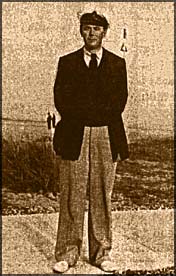
Rex Janson, our host.
That afternoon, after the races, Rex Janson took us to our hotel to retrieve our luggage, and then to his home. The Jansons's home we found to be a very handsome mansion of a type seldom seen in our suburbs. The house was built with its back to the street, built on a corner lot which included the entire end of the block. It was designed to face the interior garden and lawn which, along with the house, were enclosed by a stone wall some eight feet high which gave complete privacy. The living and dining rooms opened with wide folding glass doors onto a wide terrace and the gardens. What a delightful change this was from our hotel rooms; to be in such a lovely house, a home with a housemaid and a cook to cater to our wants and to be the guests of the charming upper-class couple Rex and Kirsteen proved to be.
Roger, Uffa and Roger's new canoe, the Wake, arrived early Wednesday morning in time for the first heat of the Royal Canoe Club Challenge Cup. Wake, Uffa's latest and best, was his latest development from the English canoes of 1933. Uffa had refined the lines and softened the curves, taking away much of the 'brute-force" appearance of the earlier boats. Being built to the new International rules adopted by both countries, she was lighter in weight, carried a shallower and lighter centerboard, and was built with a shallow vee'd cockpit. The rig was sloop with jib and main. The mast was stepped on deck, a featherweight hollow spar stiffened with double diamond stays and supported by main shrouds and jib stay. As Uffa later wrote,
The plans of Wake show the fastest canoe ever yet designed or built, for on all points of sailing Wake could outsail their other [English] boats, while she was able to defeat the Canadian challenger, even in the light weather that prevailed for the series. This was the only weather in which the challenger stood a chance at all, for like most American canoes she had to be held upright once her mast was stepped to save her from capsizing, whereas our canoes come in, pick up their moorings, and their crews stand and walk about their decks quite happily.
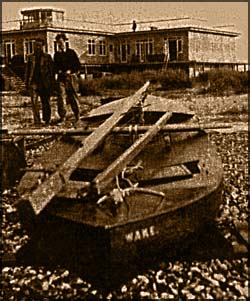
Roger de Quincey's canoe, Wake
Roger had had the experience of sailing in Cowes Week against the best English canoes, and in addition had spent the week following sailing every day against Uffa. This gave him good practice and enabled him to tune up Wake to perfection. I could see that I would have my hands full.
The wind stayed light for the three races for their Challenge Cup. Wake was three minutes late at the start of the first race and had to catch up to, and sail through, the other boats, while I was able to pull out in front and to win by seven minutes. In the light going I appeared to have an edge. For the second heat, in slightly stronger wind, perhaps six to eight miles per hour, we were very nearly equal. I managed to lead Wake, covering tack for tack, as we beat against the wind and tide for the finish line. Roger held a long starboard tack far out beyond the finish line, far beyond any lay line to the finish. Not seeing any good reason for chasing him, I headed for the finish line, far ahead of him. Bucking the wind and tide, I slowly gained on the tide and slowly closed the distance to the line. I was nearly there. In the meantime, Roger found a back-eddy behind the sandbar in the middle of the harbor entrance, an eddy which rapidly carried him up and around the bar, out into the swift incoming tide. By now he must have been 150 yards upwind of the finish line, and with the wind and the tide behind him he came blasting down on a broad reach. By now I was only a couple of lengths from the finish line, but Roger slipped around the end of the line and swung in ahead of me! Again local knowledge. Who ever would have thought of such a maneuver?
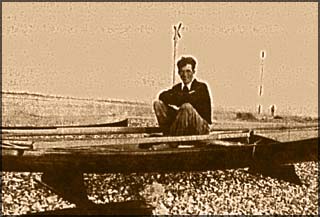
Roger and his canoe
For the final heat of the Challenge Cup, held back to back, the wind increased to ten to twelve miles per hour, and in this stronger wind Wake came to life, leading all the way around the course and winning the Challenge Cup with two firsts and a second. The International Cup races promised to be interesting with the outcome depending on the weather. My only hope appeared to be in light weather.
The International Cup course was set farther into the harbor to get away from the swiftest tide near the entrance, and the races were to be started at the leeward mark because the American Canoe Association has a rule which reads, "All races shall be started to windward when practicable and under a time limit."
Up to now I had used my sloop rig without the supposed benefit of the rotating fairing (page Dr. Manfred Curry!) on the mast because the English sail-area measurement rule did not permit it. However, there being nothing in the International rules to forbid it, and thinking it should be advantageous, I decided to use it. Judging by the result of the first race, we shall see that at best it appeared to offer no advantage.
For a description of the International Cup races I can do no better than to use Uffa Fox's story of the races, as told in chapter 39, International Canoe Class, of his book, Sail and Power, pages 319-21. After all, Uffa can give a better account of the races than can I, because as an observer he was free to devote his entire time to watching the races, whereas I had an extremely one-sided view, a rear view, so to speak, of the goings on.
First Race, Thursday, August 20, 1936
The wind at the start was westerly and blowing only six miles an hour, the tide running 1-2 knots, so the start was at the buoy in the Chichester arm of the Harbour. The two canoes fighting for a position were late over the line, a point that does not matter when only two are racing, as the idea is to be the first of the two over, and Roger won this sparring contest, Crossing forty-two seconds behind the gun, Gordon coming fifteen seconds later and to leeward of the leader. [In this I was trying for a safe leeward position.] The difference in the weatherly qualities of the boats was most marked, as Roger could lay 1 1/2 points higher to windward than the challenger, and the two on the starboard tack opened out from each other, Roger all the time soaking up to windward as though he was being pushed bodily sideways, Gordon sagging to the south. [This was the same thing we had found back in 1933 against the English.] At this time the sun had gained a great deal of strength, and away inland the clouds on the top of rising currents told us that the wind would come in from the sea and get stronger as the day went on, which meant that it would suck in due south through the mouth of Chichester Harbor quite soon; on the committee boat we had time to watch the competitors and every cloud in the sky, as with a wind six miles an hour things were not happening very fast. Gordon, who had sagged away to the south, benefitted by this shift of wind, for it headed him right off, and when he tacked he could lay the mark. He was now sailing in a southerly wind which was slightly stronger than the westerly streak in which Roger still was sailing. The latter now tacked to the south. On his new tack Gordon was trampling along in style, and as he approached Roger it was seen that he was weathering him. When he had done this, he tacked on Roger, who also tacked, and Gordon fell on top of him, but the Canadian canoe could not tack as easily as the British defender, so Gordon fell back a little and Roger with his wind clear to leeward soon pulled up and gave Gordon a lee bow, so that he was forced to tack. From then on Roger went away, rounding the mark with a 200 yards lead.
The reach to the second mark brought no change, and Roger gybed around this one minute and five seconds ahead, the wind being down to two miles an hour. At this time it was a run back to the finishing line, and Gordon swung his jib around and close:l the gap slightly, then a breeze came and Roger opened up once more and finished the first round one minute ahead. As the wind had gone slightly southerly, most of the windward work had been taken out of the race, and at the end of the first round Roger tacked at once, laying well up for the weather mark. Here he made a mistake by not covering Gordon, who held on the same tack, working out to the south, and was soon in a much stronger breeze, and although slower to windward, because of this better breeze he weathered Roger, and was now on starboard tack; but again, Gordon's canoe, slower in stays, was unable to cover Roger, who slipped through to leeward. As the two now were sailing in the same breeze, Roger immediately began to draw away and had a thirty seconds lead at the weather mark. Half-way along the reach on the second leg of the triangle Gordon pulled up level but to leeward, the two swingIng around the mark together, Roger having to give room. As his was the inside canoe, which was also the weather berth, the Canadian naturally took the lead once they gybed, and at the end of the second round, led by fifteen seconds. Gordon again held on to the south for the stronger breeze there, and Roger tacked and laid straight for the weather buoy with his sheets slightly eased, as the wind had by now established itself in the south and was southerly all over the triangle. There is no doubt that while at the end of the first round Gordon was right and Roger was wrong in his tactics, this time Gordon was wrong and Roger right [no man yet has ever sailed a perfect race - Uffa] and so the latter took the lead once more.
The wind now had reached seven miles an hour, and though still light was enough to make the Canadian use the full length of his sliding seat and Roger half the length of his. This time when Gordon tacked to the western mark he did not jump out on the end of his slide soon enough and she capsized; and though this sounds amazing to us in this country, it must be borne in mind that all the American canoes are so fine and cut away in the bottom that they have no stability whatever. Once their masts are stepped they capsize unless they are held up, whereas our canoes are left on their moorings with their masts standing for days on end. In fact, a man sailing one of the American canoes is exactly like a man walking a tight rope, he balances her all the time with his weight on the sliding seat, and his canoe will capsize if he is forgetful for one second only, everything having to be judged and timed to a fraction of a second.
This day Gordon was using a very heavy oak sliding seat and the extra weight was just enough to make the righting of his canoe a matter of minutes instead of seconds, for although he generally gets his canoe up in five seconds, it took him on this occasion a minute and a half, all of which time Roger was reaching for what should have been the weather mark, and led by two minutes around it.
The breeze was now coming stronger, and with the sun burning up the air inshore, there was no doubt it would increase through the afternoon. So in the stronger breeze de Quincey gradually drew away throughout the rest of the race, and led by three minutes and forty-five seconds, there being no windward work at all after the second round, and very little even in that. The nine-mile course took one hour and forty-nine minutes to complete, which is a little better than 4 1/2 knots average speed. The wind at the finish was blowing fourteen miles an hour. The first round took thirty-seven minutes to complete, the second thirty-two minutes, the third twenty minutes, and the last only nineteen minutes, almost half the time of the first. So England won the first race for the New York Canoe Cup.
By way of explanation, my inability to right my canoe after my capsize was caused by more than the heavy oak seat Uffa mentions. The seat was an oak plank three-fourth-inch thick and eleven inches wide, which extended out over the water four teet. While it could have been made lighter, I considered its weight, out over the water, to be effective ballast in heavy weather. However, the seat was not really the problem. The problem lay in the excessive weight of the mast and the wooden rotating fairing which, together with the sails, proved to be more weight high aloft than I was able to lift as I leaned back, standing on the side of the canoe, pulling on the seat at just the length of my arms.
After several futile and time-consuming tries I realized that I needed more leverage. This I was able to achieve by putting a loop of jib sheet around the seat so I could lean farther back to pull. I never before had capsized that boat, and it was a shock to find that I couldn't right it. The weight aloft was not apparent when the boat floated with the mast upright. Uffa was most forbearing in not giving his opinion of, nor even mentioning, my rotating mast fairing which proved to add nothing to performance but did cause the capsize. I was very fortunate that the wind was as light as it was all through these races, offering me my best wind and sea conditions.
By this time it was obvious that my Nymph II was no match for Wake when I used my sloop rig, even with new Ratsey sails. With everything hinging on two races out of three needed for winning, it seemed only logical for me to use my ketch rig, the traditional American rig. It might do the job.
Second Race, Friday, August 21, 1936
Douglass asked for a change of course. There was no doubt the course inside was more suitable to him than the one out at sea, where the wind always was stronger than in the harbor, so he decided against the courses in the open sea, but the legs of the triangle were shortened so that they were half a mile long. On this course the canoes had to sail six rounds to make up the nine miles. The course was shortened by moving the southernmost buoys to the north.
The wind was again gentle, blowing seven miles an hour at the start, and looked like easing rather than hardening. At the start of today's race the two canoes broke through the line within one second of gunfire. De Quincey to leeward had his bow just ahead, so immediately after crossing the line Douglass had to tack to the south to get his wind clear, though he was to weather, and had Roger been a second later the Canadian would have smothered him and forced him to tack. It was one of the best starts I have ever witnessed. As it was a beat to windward. Roger went away from the very beginning, and led by exactly one minute at the weather mark, and on the reach increased this by seven seconds. On the run home he further increased his lead to two minutes fifty-one seconds, increasing it on the second round to four minutes. Gordon Douglass had chosen his ketch rig for todays race, but it did not seem to be any better than the cutter rig, in spite of the fact that he was sailing and handling his canoe better with this rig; with the wind remaining true in direction there was no doubt de Quincey would win, in spite of the fact that at the end of the second round it had died down to four miles an hour. At times he was three-quarters of a mile ahead.
With a time limit of three hours for the nine mile course, it was doubtful whether Roger would complete it in the time with so light a wind. It meant that each round had to be completed in half an hour, and the fifth round took more, for at times the canoes were in very calm spots and hardly moving. However, this was the only round which was so slow, as the wind picked up a little for the last round before it died away altogether. The defender finally won by five minutes fifty-seven seconds. By winning two straight races de Quincey was successful in his defense of the trophy.
The full-bodied defending canoe, built to the maximum dimensions, had defeated the challenger with its finer underwater body in the light weather that had prevailed. In the trial races in Long Island Sound, Nymph II had proved superior, on all points of sailing, to the best canoes America had.
So ended my challenge for the International Challenge Cup of the New York Canoe Club. Since that time there have been several more challenges for the Cup. The 1948 challenge by Lou Whitman and Adolph Morse (with Morse sailing my re-rigged Nymph II) [also raced at Hayling Island] was defeated by the English. In 1952 Whitman won the Cup, this time sailing his Whitman-designed Manana II. The year 1955 saw an unsuccessful challenge by Bill Kempner of England. Kempner was successful in 1959, this time sailing a Manana II design. Whitman tried to get the trophy back in 1961 but failed; and in 1974 the Cup was won by Sweden. Will the Cup soon be returned to this country?
At the Royal Canoe Club dinner that night I was welcomed as an honorary member of the club, and also as a newly elected honorary member of the Hayling Island Sailing Club. And Roger de Quincey was presented the Challenge Cup once again. Excellent and cheerful speeches were made by H. J. Deane, the captain of the Hayling Island Sailing Club and by Hugh Campkin, vice-commodore of the Royal Canoe Club, who explained that he officiated at that time because the club had no commodore, the late commodore having had to decide between remaining the commodore or becorning the King of England, and had chosen the latter. We all were called on for speeches, and in his turn, Uffa presented me with a set of plans for Wake, commenting that "these plans bring America right up to us in canoe design." He proved to be right. My Foxy Nymph, so named in Uffa's honor, won every race she sailed in the following two years, as long as I had her.
From Chichester Harbor we shipped Nymph II for Gananoque, while the English canoes headed for Aldeburgh, on the North Sea, for their Annual Meet the following week. Mary, Father and I rented a little English Morris saloon with a sun roof, and headed north for a few days' tour of southern England before we, too, went to Aldeburgh, in Suffolk. Aldeburgh (pronounced Allboro) is an old town which formerly was a seaport on the North Sea, about twenty-five miles south of Lowestoft and a hundred miles north of London. Aldeburgh is on the bank of the Alde River which, at the time of its founding, there entered the North Sea. But so severe has been the erosion of the shore that the town has been cut back several city blocks in the last thousand years, resulting in a sand spit, parallel to the shore, which the river follows south for thirteen miles before it at last empties into the sea. Our sailing races were held on the river, a tidal river with several feet of rise and fall. The least current would be near the river banks, which meant sailing through the anchorages of the numerous cruising boats on their moorings.
This would again mean a very different experience for a fresh-water sailor, and another problem was that I would sail Gallant, one of the English canoes with a sloop rig, with a hand-held main sheet and a tiller with a long extension, a rig very different from anything I had known. I discovered, too, that when the tide ebbed it ran quite swiftly out in the channel but less rapidly near the shore. The problem, then, was to try to judge the depth of the water near the shore, and with a very soft mud bottom, there was no way to tell if your centerboard were dragging through the mud until you found a boat farther out going past you. Learning to handle the English rig proved to be quite a challenge, especially with lots of short-tacking necessary, and against some of the very best English sailors I did not really shine on such short acquaintance.
Our hosts were the de Quinceys, Roger's parents, who had a charming old home in Aldeburgh, a city block inland from the sea. When I commented to Roger that the house appeared to be very old (by our standards), Roger matter-of-factly replied that it was not really very old, only about three hundred years. (When we many years later visited him on the Isle of Wight, he was living in the remaining wing of what had been a royal palace dating to the fifteenth century.) I wonder, forty-five years later, if the house in Aldeburgh still stands, or if the North Sea by now has taken it?
The day being warm, Uffa and Roger invited me to go with them for a swim in the North Sea. I declined, but watched them, side by side, strolling down the beach, wading into the water, laughing and splashing each other, to swim in the icy fifty-degree water! I can't help but admire the fortitude of the English!
After the races Mary and I drove Father to Southampton for his return to Montreal, while we continued our tour of England for another week prior to our return on the Georgic. One vivid memory is of our rainy day in the Scottish Highlands made memorable by the sunroof of our Morris which, in addition to letting in the sun on sunny days, also let in the rain on rainy days. We drove over the Highiands with our opened umbrella over our heads inside the car.
We had a grand return trip on the Georgic. This end-of-summer return to the United States brought together a large group of young college people who made the most of being together, their high spirits manifested by much group singing, mostly, of course, in unison. But from among the group I heard part singing. Three others heard it too, and soon we left the crowd to form a barbershop quartet. The lead singer was from the Glee Club of the University of Tennessee, the tenor from the Glee Club of Anderson University, the bass from St. Olaf's Choir, and I filled in the baritone. During the succeeding days we practiced together to build a small repertoire, and in the usual ship's entertainment contest we were clearly the outstanding performers. To our amazement the Purser awarded first prize to a small girl's solo, and didn't even mention us. He later told us that he was sorry, we were the best, but that he had only one prize! We felt he could at least have mentioned us and explained why it was that he gave the prize to the young girl.
When we reached New York we invited the quartet members to weekend with us at Lake Hopatcong, but only our lead singer, Sizer Chambliss, from Chattanooga, was able to accept. Sizer was a tall, thin, hollow-legged collegian who always seemed hungry. When we asked him what he would like to have for breakfast he suggested Grape-Nuts. He explained that he liked Grape-Nuts but seldom had any because Grape-Nuts was so expensive? Expensive? As a garnish over oatmeal, for example? Come breakfast, Sizer found a large bowl into which he emptied the entire boxful of Grape-Nuts, and ate the entire boxfull in one sitting! Now we understood why he so seldom had Grape-Nuts for breakfast, because of the cost!
The summer of 1936 had been an eventful one for Mary and me. I had had the disappointment of not being permitted to compete in the Olympics as a member of the Canadian Paddling Team because of my nationality, but instead had won two championships at Sudbury. Despite the disappointment of my defeat by Roger deQuincey and his Wake, I recognized my gains in knowledge resulting from the venture in the building and rigging of the canoes. It was evident to us that Wake was superior in design to our American type of canoes, but to attribute my defeat to that might seem to be a weak excuse. It was up to me to build a canoe to Wake's design and to rig the boat as Uffa designed her, but adding some ideas I had developed from my experiences with the English boats. It then would be up to me and my new boat - I which I would name Foxy Nymph in honor of her designer - to prove that I really had lost to a better boat. There was much to be done.
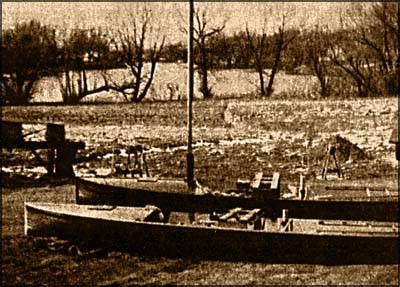
Two of my Fox canoes awaiting delivery
Ulrike_veerkamp.jpg)
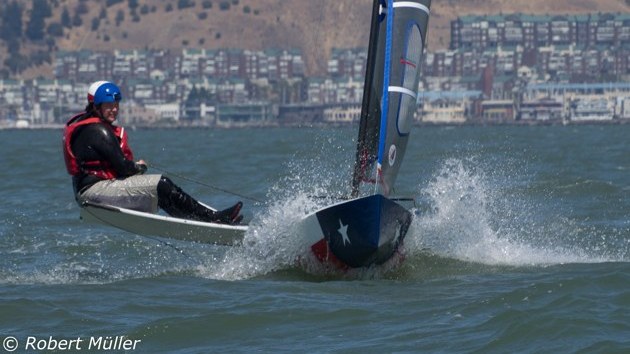
Ulrike_veerkamp.jpg)
Ulrike_veerkamp.jpg)



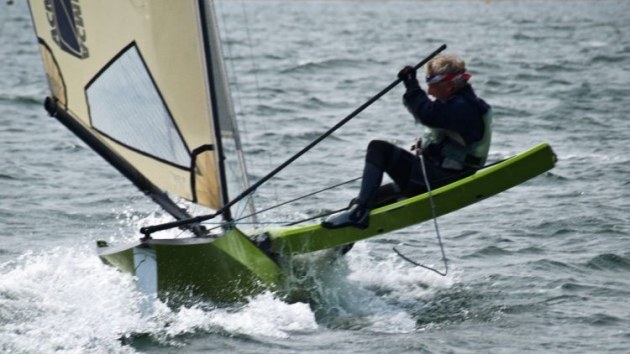
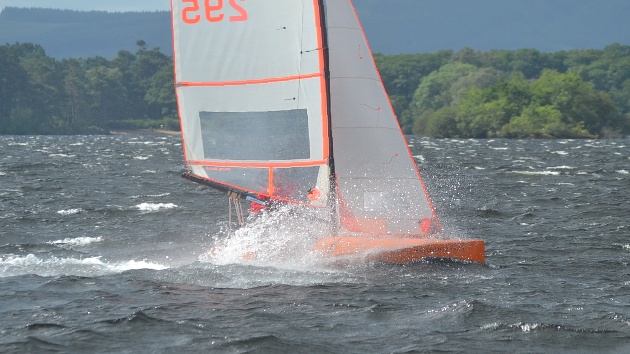
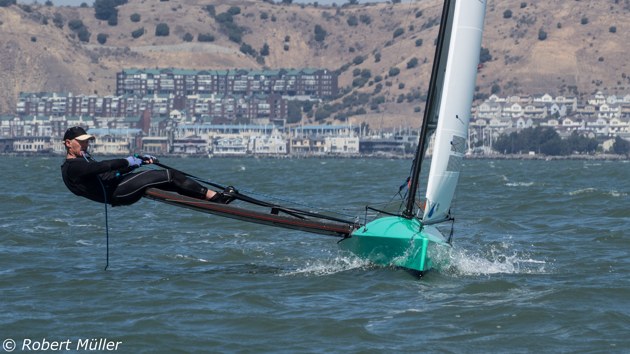
Ulrike_veerkamp.jpg)

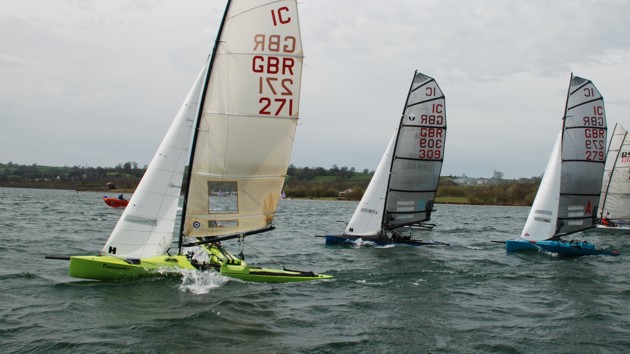
Ulrike_veerkamp.jpg)

